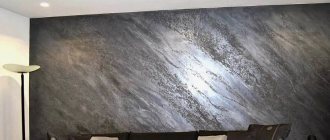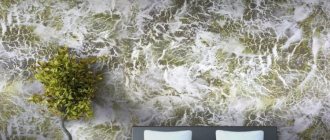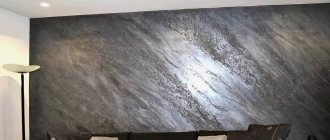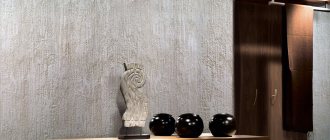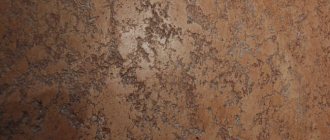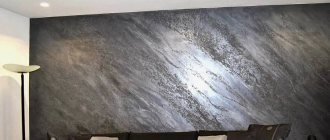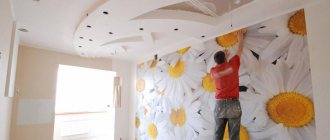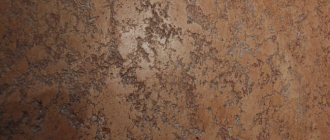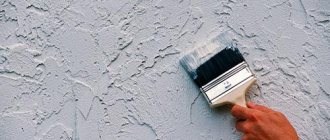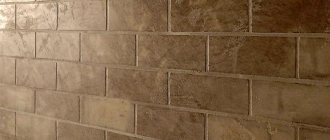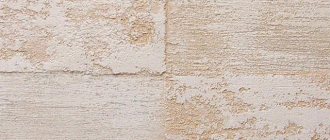Unique decorative plaster gives the walls a cracking effect. The use of this coating differs in the technique of applying the solution. It creates an amazing pattern. A decorative effect can be achieved if you use a special plaster composition. It is applied to the base using a special technology. There are several types of solution, each of them has features and advantages.
Classic version
Relevance of wall decoration
This product can make your interior decor unusual. The painting technique is based on creating a bright pattern of thin cracks, which looks like an aged, cracked surface. Vintage, Venetian style is in demand, which is why artificial aging is often used in interiors. You can achieve the result if you take a high-quality varnish, which is applied between two layers of paint of different shades.
Walls with imitation aging will be appropriate in country and classic styles. This technique can be used to modify the ceiling, doors, and windows. Even a beginner can perform such repairs.
Important! The two-component varnish requires care and patience; it takes a long time to dry. But if the wall is fairly flat, then it can be coated with a one-component product.
Finish in pastel colors
Advantages and disadvantages
Decorative plaster based on craquelure has positive and negative characteristics. This should be understood by those who decide to use it in their home. Advantages:
- High aesthetic appeal. Craquelure differs from other decorative materials. The walls will be original. There are no identical patterns, since small cracks form randomly.
- Long service life.
- Wide range of surfaces. The varnish adheres well to concrete, plaster, brick, plaster, cardboard, and other materials.
- Moisture resistance. The material is resistant to the development of pathogenic microorganisms and mold.
- Environmental Safety.
- Variability of coverage. For maximum design aesthetics, the surface can be additionally painted or varnished.
Living room decor
We must not forget about the shortcomings, which also affect the final quality of the repair:
- High price. This drawback is not related to the actual cost of the varnish, but to the fact that you will have to pay a large sum for the work of a real master.
- Difficult to apply. Craquelure is difficult to work with. To create a unique design you will have to invite a specialist or do a little training yourself.
Other options for creating cracks
Not only decorative plaster with a cracked effect can create the much-desired effect of aged walls. It can be achieved in another way. For example, you can use Craquele varnish. In this case, the surface is made smooth, then a primer or decorative paint is applied, after which the varnish is applied. Venetian plaster is applied over the varnish (another layer of paint can be used). When the coating dries, the varnish will begin to crack along with the top layer. This will create cracks through which you can see the bottom layer. Usually they make a light base under a dark topcoat or vice versa. The varnish is also blown with warm air to control the appearance of cracks. Less commonly, special paint “Crackelure” is used for these purposes. It works exactly like varnish, but the cracks are not as deep.
I would like to note that there are textured plasters that help create the effect of cracks. But this is a very labor-intensive process using special tools. It’s simply impossible to do it yourself, and the work of craftsmen is extremely expensive, and there aren’t that many qualified specialists. After all, each crack is created separately by hand, which is very labor-intensive. In this regard, decorative craquelure plaster from any manufacturer will seem like a more logical and affordable way to create a coating with a cracked effect.
DIY surface decoration
If you follow the recommendations of specialists, you can carry out the necessary repair work on your own, saving a decent amount of the family budget. To do this, you need to prepare tools and consumables:
- Protective varnish.
- Textured plaster.
- Sponge.
- Sash tool.
- Craquelure varnish.
- Putty knife.
- Multifunctional grout or acrylic enamel.
The grout and the paint itself must be chosen in contrasting shades so that the pattern stands out and is bright. Cracks can have different shapes. If the varnish is applied with a brush, the pattern will be parallel and deep. To work you need a flat brush with synthetic bristles. If you cannot do without a sponge, then it must be of the right size so that it is convenient to use. To make the pattern varied, strokes can be applied in different directions.
Stylish option
Varnish is available in two types:
- One-component. It is easy to apply to the base and dries quickly.
- Two-component. The application principle has its own peculiarities; drying takes longer. To speed up the process, use a hair dryer.
From the video you can learn how decorative painting with neat cracks is done:
Photos in the interior
craquelure plaster with cracksTyutyunnikov Dmitry
Article verified by a decorative finishing specialist
Preparing the base
Multifunctional craquelure is a finishing coating that can only be applied to a treated wall. For a good result, you need to adhere to the following scheme:
- The surface is cleaned of the previous coating. Paint and wallpaper are stripped down to the base.
- Defects are covered with putty. After drying, treat the flaws with sandpaper.
- The wall is primed.
- The putty is applied with a thickness of 2 to 4 mm.
- Conduct communications and electrical wiring.
Wall alignment
Tools for work
Various techniques can be used to decorate walls; the set of necessary tools depends on this. In any case, you need to stock up on the following set:
- putty knife;
- roller;
- paint brushes;
- foam;
- sandpaper;
- fan;
- spray gun;
- clean cloth.
To obtain small depressions, foam rubber is used in the work. To get deeper cracks, you will need a soft brush.
These tools are used to apply craquelure varnish.
Features of using varnish in practice
To work, you may need a roller, a brush, a narrow and wide metal spatula. The wall is painted with acrylic paint in two layers. This color will be visible in the cracks.
Important! Light shades are chosen as the base. Often designers use pearl and gold colors. It is better to avoid strong resonance in the shade of the base and topcoat. Otherwise, the cracks will not look natural.
The master will have to apply the first layer of craquelure and let it dry for 4 hours. If the solution is leveled horizontally or vertically over the surface, cracks will gradually appear in that order. Therefore, it is better to make multidirectional strokes so that the result is harmonious. Manufacturers indicate the drying time of the solution. In order not to wait, you can speed up the process with a hair dryer.
Applying the product with a roller
The wall must be treated with water-based paint. Add color to the plaster so that you don’t have to process it at the final stage. After the wall is blown with a hairdryer, cracks appear on its surface. A minimum of 24 hours must pass for the coating to dry completely. The master needs to remember that the thicker the layer of decorative plaster, the deeper the cracks. After the surface has dried, you can use wax, which will emphasize expressiveness. You can use enamel.
Handle joints carefully to avoid smudges and layers. Complete cracking of the coating will take 24-30 hours, then the walls are treated with a protective compound. Apply decorative varnish to painted surfaces with a sponge. You can also use natural wax. It will give the finishing layer additional attractiveness.
If the base was structural plaster, it is sanded over the entire area with sandpaper. Then use a brush to sweep the dust out of the cracks. Do not press too hard on the walls while sanding. The protective varnish is distributed over the surface, the excess is rubbed along the veins, and removed with a sponge. The product is transparent, with a silver, pearlescent or golden effect.
Master's Basic Set
Necessary materials
The cracking effect is achieved due to the difference between the drying of the base material and its coating with a special craquelure composition. Completely undried craquelure actively takes water from the paint and varnish coating and from water-based plaster, which serve as a slippery base for the material. The selection of materials is based on this principle.
You will need to prepare the following materials:
- One-component or two-component craquelure varnish;
- Acrylic paint and varnish material, selected shade to match the background;
- A special grout composition, to highlight cracks more clearly, a contrasting color is chosen;
- Relief plaster mixture, for example, Venetian;
- Primer solution;
- Varnish.
The cracking effect is achieved due to the difference between the drying of the base material and its coating with a special craquelure composition.
Application of two-component varnish
The principle of working with this tool is labor-intensive, but the effort expended is worth it, the result is excellent. The wall itself is painted in the chosen color, after which a universal varnish is applied to the dry wall. After a few hours, the procedure is repeated. Then treat the wall with finishing plaster or paint.
The decorated surface dries within 24 hours, using a hairdryer, the cracks will be more prominent and deeper. Grouting should be done after the top layer has dried. Dark shades of oil paint, gold powder, and colored dry pastels are suitable for this. Rub the product into the cracks with a soft sponge. Excess is removed with a rag soaked in vegetable oil. The finished surface is wiped with a dry cloth and a protective varnish is applied.
Decoration of large premises
The decorative surface can be smooth or embossed. You can apply textured paint. The technique is individual, but there are similarities:
- The plaster layer should not be more than 4 mm. For water-based paint, 1 mm is enough, otherwise it will be difficult to avoid the formation of smudges.
- Cracks are the main finishing elements; there is no need to create an additional bright texture. Experts recommend leaving small layers or shagreen.
- You need to work quickly and join the sections before the finishing layer hardens. Leveling the solution and creating texture should take no more than 15 minutes. When painting walls, the maximum pause is 3 minutes; if longer, the paint will pull together behind the brush.
Uniqueness of the drawing
Ideal for the bedroom
How to protect against defects
Compliance with a number of rules when performing work will help to avoid the appearance of flaws in the future:
- The temperature in the room should not be higher than +24 degrees;
- Avoid exposure to ultraviolet radiation on the wall when working;
- The presence of drafts is unacceptable;
- If the plaster is applied thickly, more than 2 millimeters, then beacons are used to obtain an even layer.
Each layer of finishing materials must dry completely before applying the next one.
Compliance with a number of rules when performing work will help to avoid the appearance of flaws in the future.
Rules of care
In order for the decorative coating to serve for a long time, you need to take into account a few simple tips: the surface should not be wetted with plenty of water, and it is forbidden to use abrasives or chemical compounds for cleaning. Do wet cleaning no more than twice a week with a soft cloth and soapy water.
Stylish decor for a cafe
Important! Craquelure is a fragile coating that can be damaged by impact or when moving furniture. The base may crack in the wrong place, which will lead to the detachment of a large fragment. Only a specialist can restore it to its original appearance.
The surface of the walls
Craquelure looks impressive and gives the room a special atmosphere. If you apply the varnish correctly and take care of it, this coating will last a long time.
The main causes of defects
Over time, defects may appear on the surface; craquelure is durable, so this is not typical for it. The causes of defects are:
- Violations of working conditions when applying the coating should not expose it to moisture and ultraviolet rays when the surface dries. The room should not have high humidity. Delaying the application process, the finish must be applied in one day;
- If too much water is added to the solution, this will show up later. When the coating was not carried out on a completely dry surface, the flaws of such errors will appear over time;
- Bad composition. Violation of proportions during preparation or terms of use.
Over time, defects may appear on the surface; craquelure is durable, so this is not typical for it.

